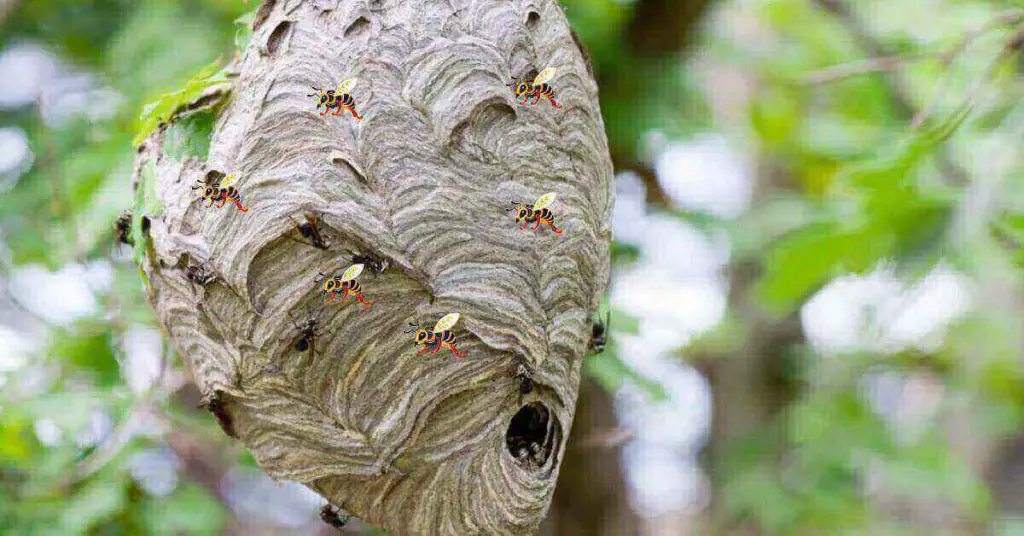Natural beehives are cavity in a tree or rock formation that serves as the home of a bee colony. Unlike man-made hives, natural hives are not artificially created by humans but occur naturally in the environment. These hives are often found in hollow trees, rock crevices, or wall cavities. The bees within a natural hive are typically wild honeybees. Wild honey bees build their wax combs and produce honey and wax for their colony’s use.
The colony in a natural beehive is usually much smaller than a man-made hive. In natural hives bees are often more aggressive as they do not have the human intervention to protect them. These hives also provide valuable habitats for other species, such as birds, bats, and insects. Deforestation, habitat destruction, and the use of pesticides can threaten the survival of natural beehives. As such, it is important to preserve natural habitats and balance human activities and wildlife protection.
Types of Natural Beehives.
Bees create several types of natural beehives in rocks and trees. Some of the most common types include:
Rock Cavities
Natural cavities in rocks, cliffs, or walls that provide shelter for bees. Solitary bees, such as masonry bees, use them as a nesting site, and they can range in size from a small aperture to a large cavern.
Tree Cavities
Bees buid nest in nest which are called tree cavitive or natural beehive. Tree Cavities are hollows in dead or dying trees created by decay or damage, such as from a broken limb or bark removal by insects. Bees such as honeybees, bumblebees, and solitary bees use cavities on trees as a safe and secure home.
Aerial Hives
Bees construct open-air hives on branches or suitable structures. Some species, such as the orchard bee, are known for creating aerial hives from materials like mud, resin, or wax.

Underground Hives
Many times bees build nests in the ground. These hives are created by bees nesting in the ground, such as the alkali bee. The bees dig tunnels into the soil, creating a network of chambers that serve as a home for their colony.
Each type of natural beehive offers unique benefits and challenges for the bees, but all provide a vital source of food, shelter, and protection for the colony. By understanding the different types of natural beehives, we can better appreciate the diversity and complexity of the bee world. We need work to protect these valuable habitats for future generations.
Hollow Trees Natural Beehives
Hollow Trees Natura Beehives offer a unique and sustainable solution for supporting bee populations and promoting biodiversity. These innovative beehives are designed to mimic the natural habitat of bees while also providing numerous benefits for both the environment and beekeepers.
The concept behind Hollow Trees Natura Beehives is to recreate the hollow spaces within trees that bees naturally inhabit. By using eco-friendly materials such as wood and natural resins, these beehives provide a safe and comfortable shelter for bees to establish their colonies. This design not only promotes the well-being of bees but also ensures minimal disruption to their natural behaviors.
Related Articales:
- How Many Beehives Per Acre.
- Fireweed Honey Uses, Qualities and Benefits.
- How many legs does a bee have?
- How much honey does a bee make?
Which type of natural beehive bees created the most?
It is difficult to determine what type of natural hive most bees have built. Usually it depends on the bee species and their specific habitat needs. Many species of bees, including honeybees and bumblebees, widely use tree hollows as a type of natural habitat.
Factors such as the age and health of the trees can influence the availability of suitable tree cavities. The presence of other wildlife that may compete for the same cavity. As a result, the creation of tree cavities as beehives can be unpredictable and may vary from year to year and from region to region.
Which type of natural beehive do honey bees create?
Honey Bees create hives in tree cavities, typically in dead or dying trees. The bees will use the cavity to build their comb, store honey, and raise their young. The tree cavity size is important for honeybees as they require a certain amount of space to build their colony and store food.
In which season bees start creating beehives?
The season in which bees start creating beehives varies depending on the species of bee and the climate in which they live. Most species of bees begin creating their hives in the spring or early summer. Bees create hives when temperatures start to warm and flowers bloom, providing a source of food for the colony.
For honeybees, the timing of hive creation is closely linked to the availability of nectar and pollen, which are crucial for the growth and survival of the colony. The queen bee will start laying eggs, and the worker bees will begin constructing the comb and storing food for the young.
Summary
Natural beehives are an important part of the ecosystem and provide valuable resources for the bees and the wider environment. By preserving these hives, we can ensure the survival of wild honeybees and protect the delicate balance of nature.
